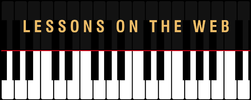|
Playing the piano incorporates a lot of different activities at one time; physically and mentally. Even when we are simply reading sheet music – we can’t get the whole picture by just reading the notes alone. We have the key signature, the time signature, dynamics and even articulations that we have to constantly read along with the notes to really play what the composer intended. The key signature tells us what notes to play sharp or flat, the time signature tells us how many beats to count in each measure and what type of note gets the beat, dynamics tell us where to play soft or loud, and articulations tell us how to play the notes. Today we’re focusing on how to play notes in two different ways; legato and staccato. Once you learn how to recognize these different articulations in your sheet music and play them on the piano, you will really enjoy how much better they make your playing sound! Legato means to play long notes and Staccato means to play short notes. Think of them as opposites. It’s also easy if you correlate the first letter of each one to help you remember which is which: legato = long and then staccato = short. In sheet music, any note that we see with a dot over (not beside) it, is a staccato/short note. They are very easy to recognize and will be the only notes with a dot over them.
On the other side of things, legato notes in our sheet music are indicated by long curvy lines that cover a number of sequential notes, or notes that come right after each other. These curvy lines are called slurs and serve to connect all of the notes underneath the slur to create a smooth, connected sound.
As you will hear in the video at the end, adding in staccato and legato articulations to your playing makes a huge difference. They provide structure to the notes so that they make more sense, are easier to listen to and are more fun to play. Incorporating articulations into your piano playing is the beginning of working with musical expression and phrasing. These terms describe the part of music that hits us emotionally, intellectually and even spiritually. We end up using dynamics along with articulations to express the deeper qualities of the music and its own unique character. It takes a little time to learn how to easily play these different articulations and it’s important to know how to practice them so you can master them quickly. You can start by simply taking an easy scale that you really know well and play it through one time with legato notes and then another time with staccato notes.
Now…to really help this all make sense it’s important to watch the following video that goes over this information at the piano. I also give you a couple of extra tips on how to play these articulations that will help you rhythmically and will give you some extra (and brain teasing) exercises to help you master each of these techniques. If you like my tips and lessons, you will love the courses over on my website. Whether you are a beginner looking to get a solid foundation to build on or you are looking to take you existing skills to that next level, the online music courses on my website https://www.pianolessonsontheweb.com will help you do just that.
Cecelia Noonan
1/23/2021 09:52:46 pm
Very clear, friendly instruction in staccato and legato. Good to practise with scales we know. I loved this lesson as review. Learned new ideas. Need to practise now.
Reply
Leave a Reply. |
AuthorMost blogs written by Archives
June 2020
Categories
All
|

 RSS Feed
RSS Feed